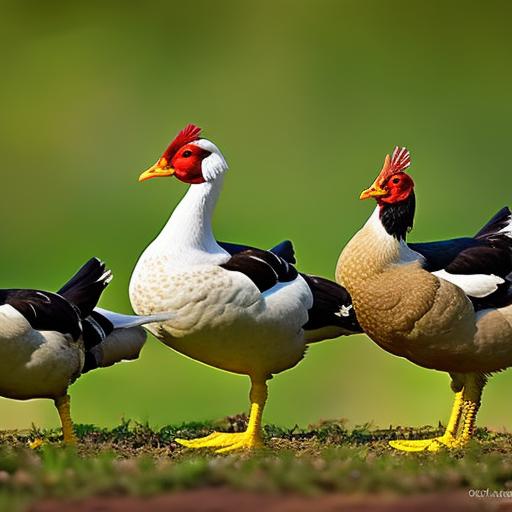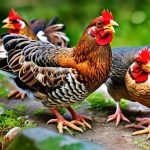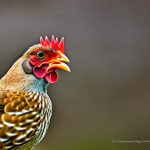Indian Runner Ducks and chickens are two popular types of poultry that are often kept together on small farms and homesteads. Both animals have their own unique characteristics and benefits, which is why many people choose to keep them together. Indian Runner Ducks are known for their upright posture and distinctive long, slender bodies, while chickens come in a variety of breeds with different sizes, shapes, and feather patterns.
One of the main reasons people choose to keep Indian Runner Ducks and chickens together is because they can complement each other in terms of pest control. Indian Runner Ducks are excellent foragers and can help control insects, slugs, and snails in the garden. Chickens also enjoy foraging and can help keep the area clean by eating bugs and weeds. Additionally, both ducks and chickens can provide companionship and entertainment for each other.
Key Takeaways
- Indian Runner Ducks and Chickens are both popular backyard poultry options.
- Indian Runner Ducks are taller and slimmer than chickens, with longer necks and legs.
- Keeping Indian Runner Ducks and Chickens together can provide benefits such as pest control and increased egg production.
- Challenges of keeping them together include differences in diet and social dynamics.
- Housing and feeding requirements should be carefully considered to ensure the health and safety of both species.
Understanding the Differences between Indian Runner Ducks and Chickens
There are several physical and behavioral differences between Indian Runner Ducks and chickens. Indian Runner Ducks have a distinctive upright posture, long necks, and slender bodies. They have webbed feet that make them excellent swimmers, but they are not as good at flying as chickens. Chickens come in a variety of breeds with different sizes, shapes, and feather patterns. They have shorter necks, rounder bodies, and clawed feet that are adapted for scratching the ground.
In terms of behavior, Indian Runner Ducks are known for their curious and active nature. They are always on the move, exploring their surroundings and foraging for food. Chickens are also active animals but tend to be more focused on scratching the ground for insects and pecking at plants. Indian Runner Ducks are generally quieter than chickens, although they can still make some noise when they are excited or alarmed.
When it comes to egg-laying, Indian Runner Ducks are known for their high egg production. They can lay up to 300 eggs per year, depending on the individual duck and its diet. Chickens also lay eggs, but the number of eggs they produce can vary depending on the breed. Some chicken breeds are known for their high egg production, while others are more focused on meat production.
Benefits of Keeping Indian Runner Ducks and Chickens Together
There are several benefits to keeping Indian Runner Ducks and chickens together. One of the main benefits is pest control. Both ducks and chickens are excellent foragers and can help control insects, slugs, and snails in the garden. They can also help keep the area clean by eating bugs and weeds. This can be especially beneficial for organic gardeners who want to minimize the use of pesticides.
Another benefit of keeping Indian Runner Ducks and chickens together is companionship. Ducks and chickens are social animals that enjoy the company of others. They can provide entertainment and companionship for each other, which can be especially important for animals that are kept in small flocks or in urban environments where they may not have access to natural social interactions.
In addition to pest control and companionship, keeping Indian Runner Ducks and chickens together can also increase egg production. Indian Runner Ducks are known for their high egg production, while some chicken breeds are also known for their high egg production. By keeping both ducks and chickens together, you can potentially increase the number of eggs you get each year.
Challenges of Keeping Indian Runner Ducks and Chickens Together
While there are many benefits to keeping Indian Runner Ducks and chickens together, there are also some challenges that need to be considered. One challenge is that ducks and chickens have different dietary needs. Ducks require more water than chickens and need access to a water source deep enough for them to submerge their heads in order to clean their nostrils and eyes. Chickens, on the other hand, need access to a dry area where they can dust bathe to keep their feathers clean.
Another challenge is that ducks and chickens have different housing requirements. Ducks need access to water for swimming, while chickens do not. Ducks also require more space than chickens, both in the coop and in the run. Additionally, ducks can be messy and produce more waste than chickens, so their housing needs to be cleaned more frequently.
A potential challenge of keeping Indian Runner Ducks and chickens together is the potential for aggression. While ducks and chickens can generally coexist peacefully, there is always a risk of aggression, especially during mating season or if there is limited space or resources. It is important to monitor their behavior and provide enough space and resources to minimize the risk of aggression.
Housing Requirements for Indian Runner Ducks and Chickens
When it comes to housing Indian Runner Ducks and chickens together, there are a few key considerations to keep in mind. The coop and run size should be large enough to accommodate both species comfortably. Ducks require more space than chickens, so it is important to provide enough room for them to move around and exercise. The coop should also have separate areas for nesting and roosting, as ducks prefer to nest on the ground while chickens prefer elevated nesting boxes.
Nesting boxes should be provided for both ducks and chickens. Ducks prefer to nest on the ground, so a shallow box filled with straw or shavings can be provided for them. Chickens prefer elevated nesting boxes, so boxes should be placed at a height that is comfortable for them to access. It is important to provide enough nesting boxes for all the hens to prevent competition and stress.
Water sources are also important for both ducks and chickens. Ducks require access to a water source deep enough for them to submerge their heads in order to clean their nostrils and eyes. This can be provided in the form of a shallow pool or a large water container. Chickens also need access to water, but they do not require a deep water source. A water container that is elevated off the ground can be provided for chickens.
Feeding Requirements for Indian Runner Ducks and Chickens

Indian Runner Ducks and chickens have different dietary needs, so it is important to provide them with appropriate feed and supplements. Ducks require a diet that is higher in protein and lower in carbohydrates than chickens. They also require more water than chickens, both for drinking and for cleaning their nostrils and eyes. Ducks can be fed a commercial duck feed or a mix of grains, vegetables, and insects.
Chickens have different dietary needs and can be fed a commercial chicken feed or a mix of grains, vegetables, and insects. They also require access to grit, which helps them digest their food. Chickens can be fed separately from ducks to ensure that they are getting the appropriate feed and supplements.
Feeding schedules should also be considered when keeping Indian Runner Ducks and chickens together. Ducks can be fed once or twice a day, while chickens can be fed multiple times throughout the day. It is important to monitor their feeding habits and adjust the feeding schedule as needed to ensure that all animals are getting enough food.
Supplemental treats can also be provided to both ducks and chickens. Ducks enjoy leafy greens, vegetables, and insects, while chickens enjoy fruits, vegetables, and grains. Treats should be given in moderation to prevent obesity and nutritional imbalances.
Health Concerns for Indian Runner Ducks and Chickens
Indian Runner Ducks and chickens are generally hardy animals, but there are some common health concerns that need to be considered. Both ducks and chickens are susceptible to respiratory infections, parasites, and other illnesses. It is important to monitor their health regularly and seek veterinary care if necessary.
Common illnesses in ducks include respiratory infections, bumblefoot (an infection of the foot), and egg binding (when an egg gets stuck in the reproductive tract). Common illnesses in chickens include respiratory infections, mites and lice infestations, and egg-related issues such as egg binding or egg peritonitis.
Preventative measures can be taken to minimize the risk of illness in Indian Runner Ducks and chickens. This includes providing a clean and dry living environment, regular cleaning and disinfection of the coop and run, and regular health checks. It is also important to provide a balanced diet and access to fresh water.
Social Dynamics between Indian Runner Ducks and Chickens
Indian Runner Ducks and chickens can coexist peacefully, but it is important to understand their social dynamics. Ducks and chickens have different social structures, with ducks being more egalitarian and chickens having a pecking order. When introducing ducks and chickens, it is important to do so slowly and monitor their behavior to ensure that there is no aggression or bullying.
The pecking order in chickens can sometimes lead to aggression, especially if there is limited space or resources. Signs of aggression in chickens include pecking, chasing, feather pulling, and loud vocalizations. If aggression occurs, it may be necessary to separate the animals or provide additional resources to minimize competition.
Ducks are generally more social and less aggressive than chickens. They tend to get along well with each other and with other poultry species. Signs of aggression in ducks include chasing, biting, hissing, and loud vocalizations. If aggression occurs, it may be necessary to separate the animals or provide additional space to minimize competition.
Tips for Successfully Keeping Indian Runner Ducks and Chickens Together
To successfully keep Indian Runner Ducks and chickens together, there are a few tips that can be followed. First, it is important to introduce them slowly and monitor their behavior. This can help prevent aggression and ensure that they are getting along well. It is also important to provide plenty of space for both species, both in the coop and in the run. This can help minimize competition and reduce the risk of aggression.
Regular monitoring of their behavior is also important. This includes observing their interactions, feeding habits, and overall health. Any changes in behavior or health should be addressed promptly to prevent further issues.
Is Keeping Indian Runner Ducks and Chickens Together Right for You?
Keeping Indian Runner Ducks and chickens together can be a rewarding experience, but it is important to consider the benefits and challenges before making a decision. The benefits of keeping them together include pest control, companionship, and increased egg production. However, there are also challenges to consider, such as different dietary needs, housing requirements, and the potential for aggression.
If you are considering keeping Indian Runner Ducks and chickens together, it is important to provide appropriate housing, feed, and care for both species. It is also important to monitor their behavior and health regularly to ensure that they are getting along well and are in good health.
Overall, keeping Indian Runner Ducks and chickens together can be a great way to enhance your poultry flock and enjoy the benefits of both species. With proper care and attention, they can coexist peacefully and provide you with years of enjoyment.
If you’re considering keeping Indian Runner ducks with chickens, you may want to check out this informative article on Poultry Wizard’s website. They provide valuable insights on how to turn a shed into a chicken coop, which can be a great solution for housing both ducks and chickens together. This article offers practical tips and advice on creating a suitable environment for your feathered friends. To learn more, visit https://poultrywizard.com/keeping-chickens/turning-a-shed-into-a-chicken-coop/. For additional resources and information on poultry keeping, be sure to explore the rest of the Poultry Wizard website at https://poultrywizard.com/ and consider checking out their article on the SnapLock chicken coop at https://poultrywizard.com/keeping-chickens/snaplock-chicken-coop/.
FAQs
What are Indian Runner Ducks?
Indian Runner Ducks are a domesticated breed of duck that originated in the Indian subcontinent. They are known for their upright posture and slender, streamlined bodies.
Can Indian Runner Ducks be kept with chickens?
Yes, Indian Runner Ducks can be kept with chickens. They are generally compatible with other poultry breeds and can coexist peacefully in the same coop or run.
What are the benefits of keeping Indian Runner Ducks with chickens?
Keeping Indian Runner Ducks with chickens can provide several benefits, including increased pest control, improved soil health, and enhanced egg production.
What are the potential drawbacks of keeping Indian Runner Ducks with chickens?
One potential drawback of keeping Indian Runner Ducks with chickens is that they may require different feed and water requirements. Additionally, ducks may be more susceptible to certain diseases than chickens, so it is important to monitor their health closely.
How should Indian Runner Ducks be introduced to a flock of chickens?
When introducing Indian Runner Ducks to a flock of chickens, it is important to do so gradually and under close supervision. It may be helpful to keep the ducks and chickens separated at first and gradually introduce them to each other over a period of several days or weeks.
What should be considered when designing a coop or run for Indian Runner Ducks and chickens?
When designing a coop or run for Indian Runner Ducks and chickens, it is important to consider the space requirements of both species. Ducks require more water than chickens, so it may be necessary to provide a separate water source for them. Additionally, ducks may be more prone to predators than chickens, so it is important to ensure that the coop or run is secure and predator-proof.
Meet Walter, the feathered-friend fanatic of Florida! Nestled in the sunshine state, Walter struts through life with his feathered companions, clucking his way to happiness. With a coop that’s fancier than a five-star hotel, he’s the Don Juan of the chicken world. When he’s not teaching his hens to do the cha-cha, you’ll find him in a heated debate with his prized rooster, Sir Clucks-a-Lot. Walter’s poultry passion is no yolk; he’s the sunny-side-up guy you never knew you needed in your flock of friends!







